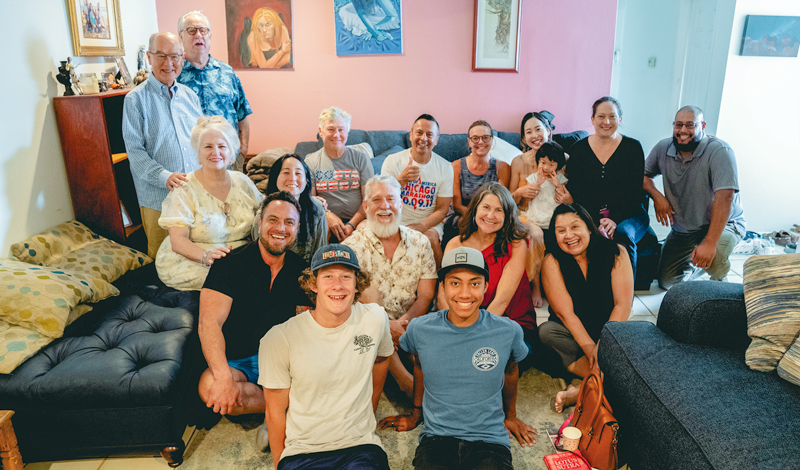The base of the Buddhist altar in the Hall of the Great Vow for Kosen-rufu houses stones collected from 192 countries and territories around the world and each of Japan’s 47 prefectures.
We will soon mark the 10th anniversary of the Hall’s completion. Nichiren Daishonin writes, “Three things are required—a good teacher, a good believer, and a good teaching—before prayers can be effective and disasters banished from the land” (“Those Initially Aspiring to the Way,” The Writings of Nichiren Daishonin, vol. 1, p. 880). Taking these words to heart, over the past decade we of the Soka Gakkai—walking the path of mentor and disciple and faithfully following the teachings of the Buddha of the Latter Day of the Law—have made dynamic strides in fulfilling our individual prayers and compassionately spreading the Mystic Law in the lands of our mission.
The driving force behind this is unquestionably our Soka Gakkai districts. I am chanting with the deepest respect and gratitude for the members of our Soka family in districts throughout Japan and the world, spearheaded by our admirable men’s and women’s district leaders. I would like to celebrate with you the decade of magnificent victory each of your districts has achieved.
In one of his letters, Nichiren conveys his dearest hope of meeting with the Ikegami brothers again, writing, “[At that time] I will be too overcome with joy to speak” (Gosho zenshu, new edition, p. 1498). This shows just how much he valued his encounters with his disciples. Our district discussion meetings are imbued with Nichiren’s spirit of caring and concern.
In Kansai during the pioneering days of our movement, a newly appointed district women’s leader asked me earnestly how she should approach her new responsibility.
Thanking and commending her for all her dedicated efforts, I said that she didn’t need to do anything out of the ordinary, just chant daimoku, pray for the happiness of each member and encourage them kindly and considerately. By doing so, I told her, that same spirit would spread throughout the entire district. This is the meaning of “One’s body and mind at a single moment pervade the entire realm of phenomena”[1] (“The Object of Devotion for Observing the Mind,” WND-1, 366). I urged her to promote kosen-rufu with confidence and courage, starting with encouraging and speaking with people in her immediate environment.
The verse section of the “Life Span” chapter of the Lotus Sutra, which we recite in gongyo, concludes with the words expressing the Buddha’s constant thought or concern:
At all times I think to myself:
How can I cause living beings
to gain entry into the unsurpassed way
and quickly acquire the body of a Buddha?[2]
Referring to this passage, my mentor, second Soka Gakkai President Josei Toda, declared that the wish to lead all people to happiness is the constant thought that we as Soka Gakkai members share with Nichiren Daishonin, the Buddha of the Latter Day of the Law.
Let us do gongyo each day with the spirit that we are making fresh determinations in the Hall of the Great Vow for Kosen-rufu. Let us chant for the happiness of all our district members and the happiness of all humanity, and pray to realize peace and prosperity in our communities through spreading the life-affirming principles of Nichiren Buddhism.
Chanting the lion’s roar of Nam-myoho-renge-kyo infused with our great vow for kosen-rufu, let us illuminate our planet and the future with the brilliant light of the Mystic Law!
Our noble members rejoice and dance
knowing the principle of
“emerging from the earth”[3]
is alive in their districts,
benefits in full bloom.
Originally published in the October 2023 Daibyakurenge, the Soka Gakkai’s monthly study journal.
From the November 2023 Living Buddhism
References
- Words of the Great Teacher Miao-lo in The Annotations on “Great Concentration and Insight.” ↩︎
- In gongyo, the passage reads: “Mai ji sa ze nen. I ga ryo shujo. Toku nyu mu-jo do. Soku joju busshin.” From The Lotus Sutra and Its Opening and Closing Sutras, p. 273. ↩︎
- In “The True Aspect of All Phenomena,” Nichiren writes: “At first only Nichiren chanted Nam-myoho-renge-kyo, but then two, three, and a hundred followed, chanting and teaching others. Propagation will unfold this way in the future as well. Does this not signify ‘emerging from the earth’?” (WND-1, 385). ↩︎
You are reading {{ meterCount }} of {{ meterMax }} free premium articles

